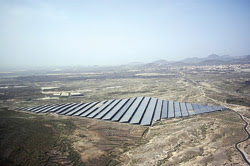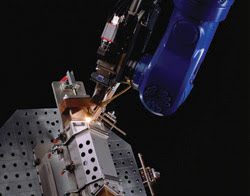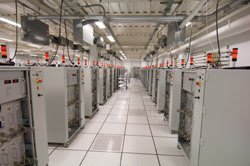Dr. Robert Molenaar, Contributing Editor
ENSCHEDE, Netherlands – Each day we become more aware of our impact on the environment, which makes reducing greenhouse gases an imperative for any energy-consuming device.
In science and industry, lasers play an essential role in environmental solutions. For instance, lasers from Coherent drill small holes in aircraft engine components, improving combustion processes and fuel efficiency in air travel.

Fuel efficiency of aircraft engines benefits from laser treatment. (Source: Pratt & Whitney)
Lasers made by Rofin cut, drill and mark solar cells, while fibre lasers from IPG Photonics find employment in producing fuel cells and batteries for electric cars.
However, lasers themselves can waste energy, contributing to the problem of greenhouse gases. It might be informative to take a closer look.

The Solten plant, the largest photovoltaic solar cell energy array in Europe, is located on Tenerife, the largest of the Canary Islands. Operating under the auspices of ITER, the island’s administrative authority, it generates a power of 13 MW. (Source: ITER)
Every electronic device has a so-called wall-plug efficiency, or WPE, which is the percentage of electrical power consumption required to operate it. A common lightbulb has a typical WPE of 2 per cent. The remaining 98 per cent is dissipated as heat. For lasers, the situation isn’t much different. The workhorses in the industry are typically Nd:YAG and CO2 lasers used for cutting, welding and marking. Classic flashlamp-pumped YAGs run at 1.5 to 2 per cent WPE. At 8 to 10 per cent, CO2 lasers do slightly better; however, their lower processing efficiency, resulting from a wavelength that is 10 times longer, immediately nullifies this advantage.
For lasers used in scientific applications, the situation is even worse. Argon-ion lasers and the widely used titanium-sapphire lasers, particularly when they are pumped with argon-ion lasers, have WPEs around 0.1 per cent.

Laser welding is an application enabling use of energy-saving laser technology. (Source: Trumpf)
Improvements in energy efficiency are becoming common these days in diode-pumped Nd:YAG laser systems, many of which achieve a WPE of around 25 per cent. Values above 30 per cent are possible, for instance with fibre lasers or with thin-disc lasers based on ytterbium:YAG laser crystals. Pure laser diode systems can reach the highest efficiencies, sometimes above 60 per cent, but their poor beam quality and their inability to generate intense pulses make them less useful for many applications. Particularly for high-power lasers, good wall-plug efficiency is a very important quality. It reduces the electrical power consumption and also the amount of heat that has to be removed. Therefore, it not only cuts down the electricity bill but also reduces the demands on electrical installations and on the cooling system.
But even for low-power lasers, efficiency can be important in areas where the power budget is tight. Examples are telecom devices with a large number of transmitters, and lasers for field and space applications operating on battery power. As an illustration of green thinking, Global Laser Ltd. has introduced a diode laser with a driver that operates in pulsed mode. This reduces the power consumption without affecting visible beam output.
Today most of the larger industrial laser manufacturers, such as Quantel, Trumpf, Electrox, GSI-Lumonics and Coherent, are turning to fibre and disc laser concepts. They offer fibre lasers with continuous-wave and pulsed output powers ranging from 10 to 300 W. Trumpf and Rofin are also making a series of disc lasers with powers up to 8 kW, and IPG Photonics is squeezing up to 50 kW out of a fibre laser. These lasers have a WPE between 25 and 30 per cent.
With so much output power, YAG lasers could easily replace CO2 lasers in many applications. For welding, this brings an extra cost savings in the redundancy of expensive inert gases, helium and argon, because feeding this on the processing spot isn’t required anymore. Further, fibre delivery systems of up to 200 m in length are possible without significant loss of beam power or quality. This allows for beam switching, which enables operation of multiple workstations from a single laser.
Diode-laser-pumped fibre and disc lasers benefit from running at both lower and higher powers without the need to compensate for the optical adjustments of thermal effects in a laser crystal. This was unthinkable for Nd:YAG lasers pumped by heat-generating flashlamps in the old days.
An important issue for users of high-energy lasers is maintenance. Downtime is a cost factor. Traditional CO2 and Nd:YAG lasers require frequent service. CO2 lasers need gas refills or laser tube exchange. In flashlamp-pumped Nd:YAG lasers, the lamps must be replaced every 200 hours, while diode lasers have average lifetimes up to 100,000 hours.

A diode laser’s long lifetime is subject to constant testing in burn-in stations. (Source: IPG Photonics)
To meet maintenance reduction requirements, some fibre laser manufacturers include more diode bars in their systems than are needed for operation at nominal power. In the event a diode bar fails, a spare one takes over, and the laser still runs at nominal power. According to Jens Bleher, managing director of Trumpf’s Laser Technology Div., there is no single ideal beam source for industrial lasers. The industrial sectors are much too different, and the applications of the various laser technologies are too complex. However, “Diode-pumped solid-state lasers and direct diode lasers will play an increasingly important role, in our opinion. The diode will become the central element for all lasers,” Bleher said.
Given all the benefits of more efficient lasers, including the energy bill savings and the near absence of maintenance downtime, it’s time to look at the situation from the view of the laser user.
Although a connection exists between new laser applications and the use of new laser technology, why are so many large production plants still using old, energy-wasting laser systems? We are told by members of the laser community that it is mainly because the expected cost savings in electricity isn’t high enough, and changing a flashlamp is a simple, routine job for a laser operator. Some major laser manufacturers keep offering energy-slurping lamp-pumped lasers.
Further, what keeps users hesitant is a persistent series of stories about back-reflection and auto-shutoff problems related to diode lasers with fibre delivery systems. According to Valentin Gapontsev, president of IPG Photonics, these issues were solved several years ago. However, he continues, users should be well aware that focused kilowatt power can melt steel, so a backreflected beam can easily damage the fibre connector if it isn’t focused directly into the fibre core but instead into the fibre cladding or onto the fibre holder or mount.
Conservative steel factories need a lot of convincing before they switch from familiar to unknown technology. In particular, they want to see proof of the promised downtime and reliability improvements, before they believe.
It’s worth it, as a 50-kW CO2 laser with old technology takes at least 500 kW from its wall plug while pumping out the remaining 450 kW as heat via the cooling system. A comparable fibre or disc laser would need less than 200 kW and can easily be distributed by beam switches to a setup with multiple workstations. Big numbers become even bigger for multilaser factories.
Although laser manufacturers are clearly making efforts to produce energy-efficient systems, a major breakthrough at the user’s end for putting them into operation en masse still has to come. Saving the environment is a slow process.